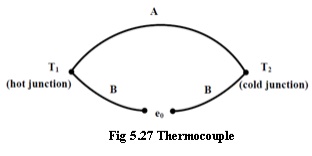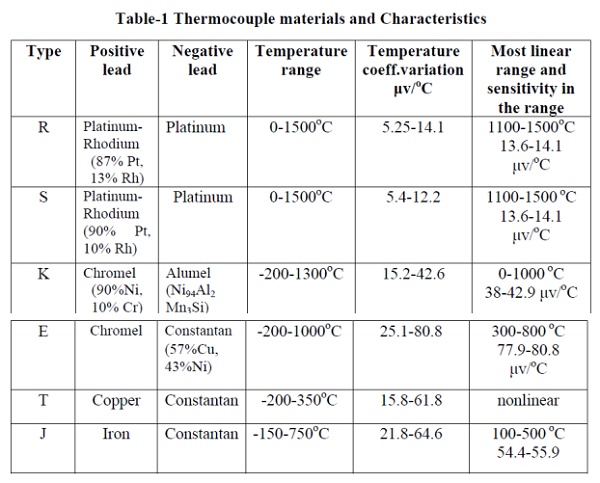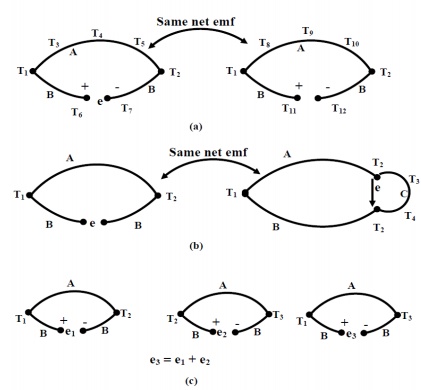Chapter: Mechanical : Metrology and Measurements : Measurement of Power, Flow and Temperature Related Properties
Thermocouples (Thermo-junctive temperature measuring devices)
THERMOCOUPLES
(Thermo-junctive temperature measuring devices)
Thomas Johan Seeback
discovered in 1821 that thermal energy can produce electric current. When two
conductors made from dissimilar metals are connected forming two common
junctions and the two junctions are exposed to two different temperatures, a
net thermal emf is produced, the actual value being dependent on the materials
used and the temperature difference between hot and cold junctions. The
thermoelectric emf generated, in fact is due to the combination of two effects:
Peltier effect and Thomson effect. A typical thermocouple junction is shown in
fig. 5. The emf generated can be approximately expressed by the relationship:

Where, T1 and T2 are
hot and cold junction temperatures in K. C1 and C2 are constants depending upon
the materials. For Copper/ Constantan thermocouple, C1=62.1 and C2=0.045.
Thermocouples are
extensively used for measurement of temperature in industrial situations. The
major reasons behind their popularity are:
(i) They are rugged and readings are
consistent
(ii) They can measure over a wide range of
temperature
(iii) Their characteristics are almost linear with
an accuracy of about 0.05%. However, the major shortcoming of thermocouples is
low sensitivity compared to other temperature measuring devices (e.g. RTD,
Thermistor).

Thermocouple Materials

Theoretically, any pair of dissimilar materials can
be used as a thermocouple. But in practice, only few materials have found
applications for temperature measurement. The choice of materials is influenced
by several factors, namely, sensitivity, stability in calibration, inertness in
the operating atmosphere and reproducibility (i.e. the thermocouple can be
replaced by a similar one without any recalibration). Table-I shows the common
types of thermocouples, their types, composition, range, sensitivity etc. The
upper range of the thermocouple is normally dependent on the atmosphere where
it has been put. For example, the upper range of Chromel/ Alumel thermocouple
can be increased in oxidizing atmosphere, while the upper range of Iron/
Constantan thermocouple can be increased in reducing atmosphere.
Laws of Thermocouple
The Peltier and Thompson effects explain the basic
principles of thermoelectric emf generation. But they are not sufficient for
providing a suitable measuring technique at actual measuring situations. For
this purpose, we have three laws of thermoelectric circuits that provide us
useful practical tips for measurement of temperature. These laws are known as
law of homogeneous circuit, law of intermediate metals and law of intermediate
temperatures. These laws can be explained using figure

The first law can be explained using figure
(a). It says that the net thermo-emf generated is
dependent on the materials and the temperatures of two junctions only, not on
any intermediate temperature.
According to the second law, if a third material is
introduced at any point (thus forming two additional junctions)
it will not have any effect, if these two additional
junctions remain at the same temperatures (figure b). This law makes it
possible to insert a measuring device without altering the thermo-emf.
The third law is
related to the calibration of the thermocouple. It says, if a thermocouple
produces emf e1, when its junctions are at T1 and T2,
and e2 when its junctions are at T2 and T3;
then it will generate emf e1+e2 when the junction
temperatures are at T1 and T3 (figure c).
The third law is particularly important from the
point of view of reference junction compensation. The calibration chart of a
thermocouple is prepared taking the cold or reference junction temperature as 0
C. But in actual measuring situation, seldom the reference junction temperature
is kept at that temperature, it is normally kept at ambient temperature. The
third law helps us to compute the actual temperature using the calibration
chart.
Related Topics